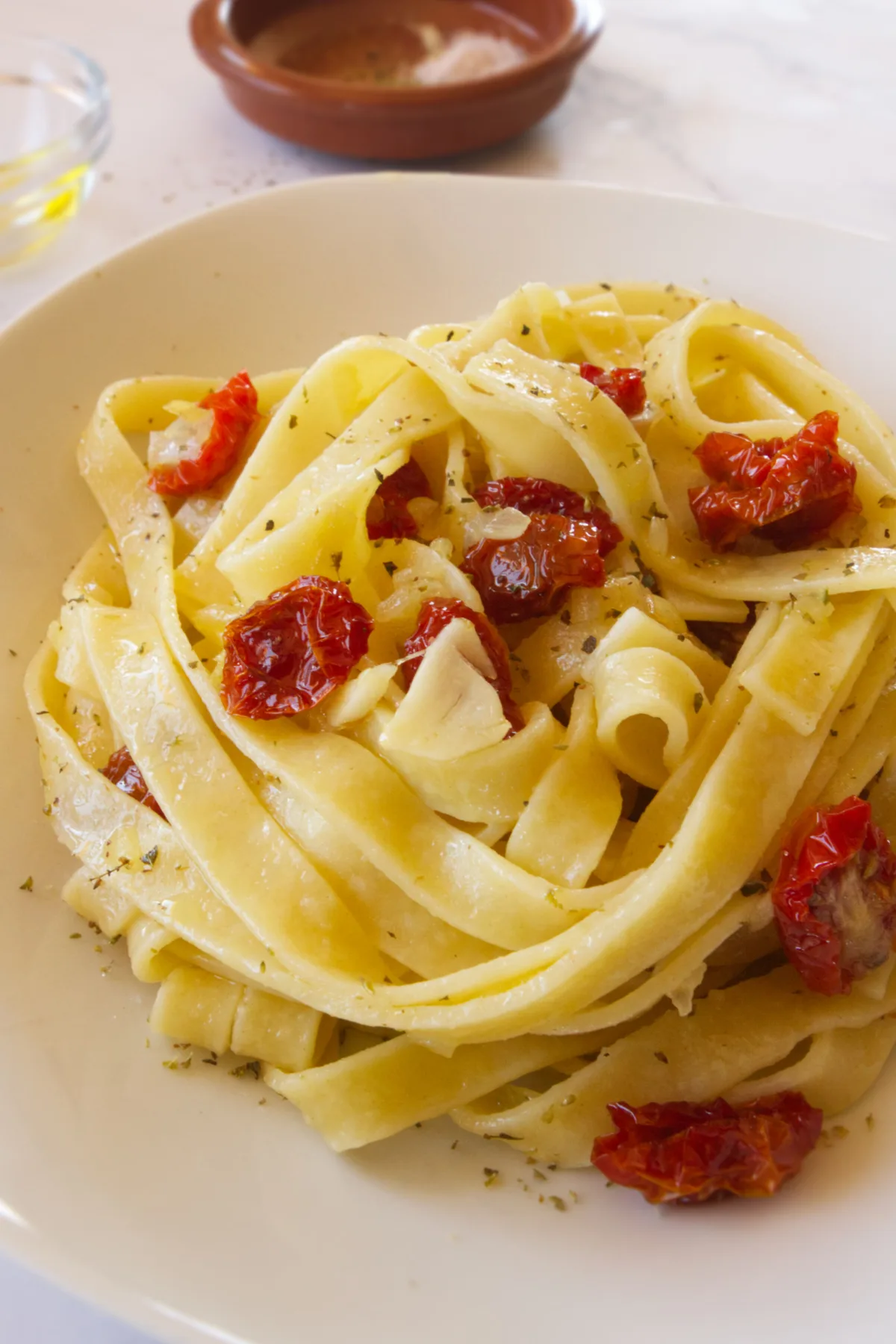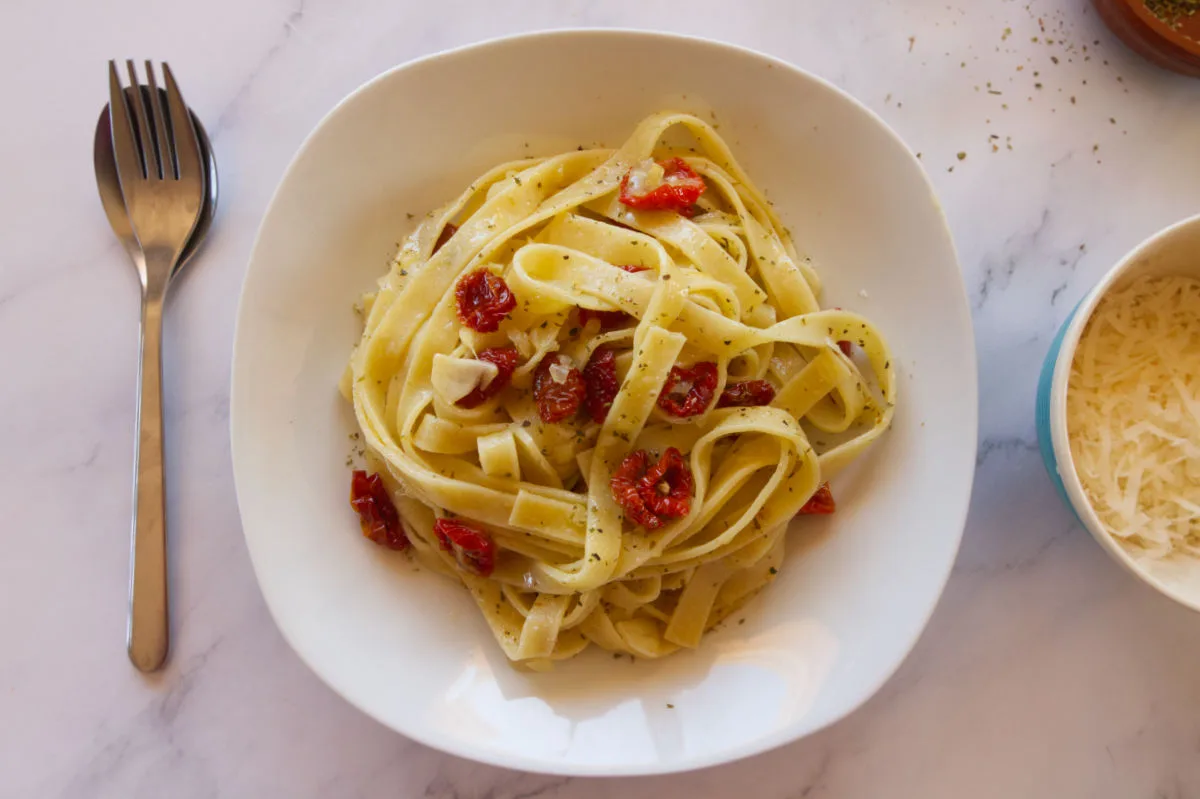Tagliatelle pasta with sun-dried tomatoes is a classic vegetarian pasta dish. It’s quick and easy to make, and uses just a select few ingredients that come together to make a dish that looks and tastes amazing.
Tangy, sweet sun-dried tomatoes marinated in oil, onion, and lightly fried slices of garlic are smothered over some pasta cooked al dente — they were made for each other. This is the base for the recipe but you can also add some cooked artichoke hearts or mushrooms, or wilt some spinach when you cook the onion and include any or all of those.
Table of contents:
- How to Cook Tagliatelle Pasta with Sun-Dried Tomatoes
- What is Tagliatelle Pasta?
- Which Sun-dried Tomatoes to Use?
- Nutrition Facts
How to Cook Tagliatelle Pasta with Sun-Dried Tomatoes
When you’re craving a sumptuous pasta dish, but don’t have a lot of time to make dinner, this recipe’s got your back. It’s quick and easy to make and requires only a handful of ingredients that are synonymous with Italian cuisine (just make sure they’re as fresh and high quality as you can source).
We love this recipe as it comes together in around 10 minutes.
- Prep time: 2 minutes
- Cook time: 8 minutes
- Total time: 10 minutes
Equipment
- Large pot
- Large pan
- Cutting board
- Sharp knife
Ingredients
These quantities make 4 servings:
- 4 tbsp extra virgin olive oil (use the oil from the sun-dried tomatoes if there’s enough)
- 1.5 lb / 680g tagliatelle pasta (fresh)
- 1 medium-sized onion, diced fine
- 4 cloves garlic, sliced
- 8 tbsp sun-dried tomatoes, chopped
- ½ teaspoon garlic powder
- 1 teaspoon dried oregano
- ½ teaspoon of white pepper
- Salt and pepper (to taste)
- Fresh basil leaves (optional garnish)
Instructions
- Put some water on to boil for your pasta and add some salt.
- In a large pan, heat 2 tbsp of olive oil and lightly brown the onion. Reduce heat to medium and add the garlic. Cook for a minute or until fragrant.
- Add the tagliatelle pasta to the water and cook according to package instructions (usually around 2-3 minutes for fresh pasta).
- Add the remaining 2 tbsp of olive oil, the sun-dried tomatoes, garlic powder, dried oregano, and white pepper to the onion and garlic and continue cooking on medium heat for 1-2 minutes, then take off the heat.
- Drain the cooked tagliatelle. Add the tagliatelle pasta to the pan with sun-dried tomatoes, garlic, and onion, then mix until the pasta is coated with the sauce.
- Taste and season with salt.
- Serve with some fresh basil leaves and grated cheese if you like.

What is Tagliatelle Pasta?
Tagliatelle is characterized by its long, flat ribbons or strips of pasta. It’s a similar shape to fettuccine but is typically narrower, about 0.25 inches / 6mm in width. Traditional tagliatelle is made from eggs and flour, and the dough is rolled out thinly, and then cut into wide strips.
Is Tagliatelle pasta suitable for vegans?
Traditional fresh tagliatelle pasta is made with eggs and flour so isn’t suitable for vegans, but there are vegan-friendly alternatives — many dried tagliatelle pasta versions don’t contain eggs, so just check the packet first and factor in a longer cooking time (around 8-10 minutes).
How Long Does Tagliatelle Pasta Take To Cook?
Fresh Tagliatelle pasta takes around 2-3 minutes to cook. Dried Tagliatelle pasta typically takes about 8 to 10 minutes, but the exact cooking time can vary depending on the thickness of the pasta and your desired level of doneness.
- When cooking the pasta, ensure the water is boiling before submerging the pasta.
- Ensure there’s enough water to completely submerge the pasta for the entire cooking process.
- Once cooked, drain the pasta water immediately and add the pasta to the pan so it is covered in the oil and sauce, stopping it from sticking together.
What does ‘al dente’ mean?
“Al dente” is an Italian phrase that means “to the tooth” or “to the bite.” When pasta is cooked al dente, it means it’s cooked just enough to be tender but still firm when bitten into.
Dried vs Fresh Tagliatelle Pasta: What’s the Difference?
Fresh and dried tagliatelle pasta differ primarily in their ingredients, texture, and flavor. Here are the key differences between the two:
Ingredients:
Fresh tagliatelle: Fresh tagliatelle pasta is typically made with eggs and flour. This pasta has a shorter shelf (or rather fridge) life and is often considered more delicate in flavor thanks to the eggs.
Dried tagliatelle: Dried tagliatelle pasta is made with durum wheat semolina flour and water. It does not contain eggs. Durum wheat is a hard wheat variety that gives dried pasta a firm texture and allows it to hold its shape during cooking. Dried tagliatelle has a longer shelf life and so is popular for its convenience and versatility.
Texture:
Fresh tagliatelle: Fresh pasta has a softer and more tender texture compared to dried pasta. It cooks relatively quickly, usually in just a few minutes, and has a silky, smooth surface.
Dried tagliatelle: Dried pasta has a firmer, chewier texture. It takes longer to cook, typically around 8 to 10 minutes, and retains a firmer bite even when cooked al dente. But, the surface of dried pasta is rougher, which helps it hold onto sauces.
Cooking time:
Fresh tagliatelle: Fresh pasta cooks much faster than dried pasta and requires only a few minutes in boiling water. Overcooking can lead to a mushy texture.
Dried tagliatelle: Dried pasta has a longer cooking time, usually around 8 to 10 minutes, depending on the thickness. It has a greater tolerance for cooking time variations and is less likely to become overcooked.
Flavor:
Fresh tagliatelle: Fresh pasta has a subtle, delicate flavor due to the eggs used in its preparation. It can complement lighter, cream-based, or seafood sauces well.
Dried tagliatelle: Dried pasta has a neutral flavor, allowing it to pair with a wide range of sauces, both light and hearty. Its texture makes it an excellent choice for thicker, meat-based, or tomato-based sauces.
The verdict:
It’s up to you which one you use but we love using the fresh in this recipe since this dish only has a handful of ingredients so it really lets the flavors shine through. But, it all comes down to personal choice, allergies, diet, and preference. If you use dried, you’ll still end up with a lovely pasta dish.
Which Sun-dried Tomatoes to Use?
We used homemade sun-dried tomatoes that we already had in the fridge. They were cherry tomatoes that were sweet, tangy, and loaded with flavor.
If you’re short on time, store-bought sun-dried tomatoes work absolutely fine. Just make sure you buy ones that are in extra virgin olive oil, as the dried version that you rehydrate tend to be more bitter and you won’t get the same result.
Learn how to make homemade sun-dried tomatoes (3 methods explored): using the oven, under the sun, and using a dehydrator.
Nutrition Facts
| Servings: 4 (Amount per serving) | |
|---|---|
| Calories | 603 % Daily Value* |
| Total Fat 17.8g | 23% |
| Saturated Fat 2.5g | 13% |
| Cholesterol 117mg | 39% |
| Sodium 45mg | 2% |
| Total Carbohydrate 92.7g | 34% |
| Dietary Fiber 1.2g | 4% |
| Total Sugars 1.9g | |
| Protein 18.9g | |
| Vitamin D 0mcg | 0% |
| Calcium 45mg | 3% |
| Iron 6mg | 32% |
| Potassium 405mg | 9% |
| *The % Daily Value (DV) tells you how much a nutrient in a food serving contributes to a daily diet. 2,000 calorie a day is used for general nutrition advice. | |


Leave a Reply